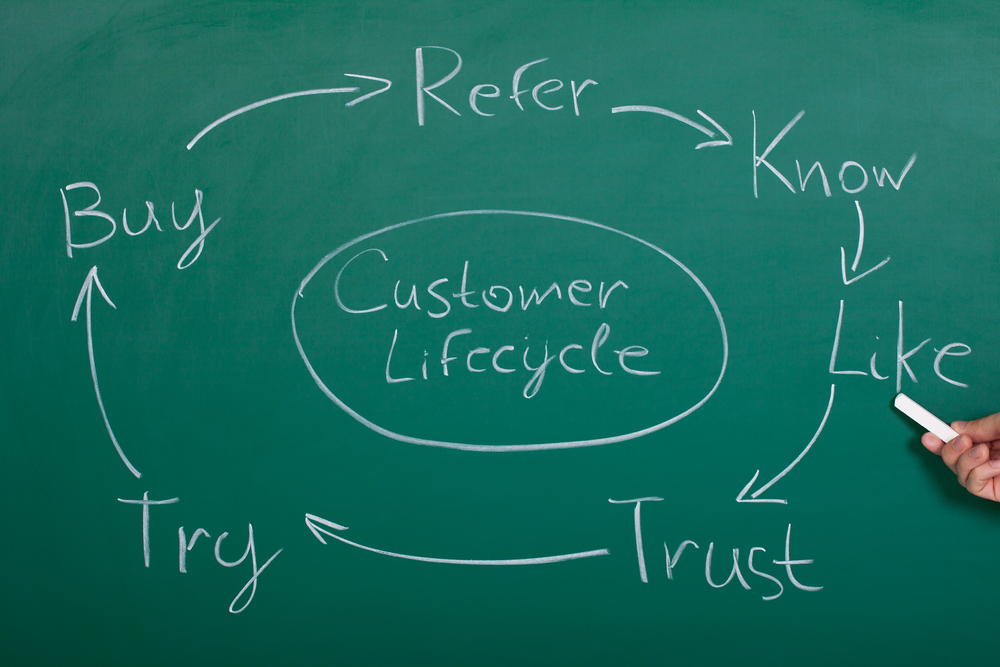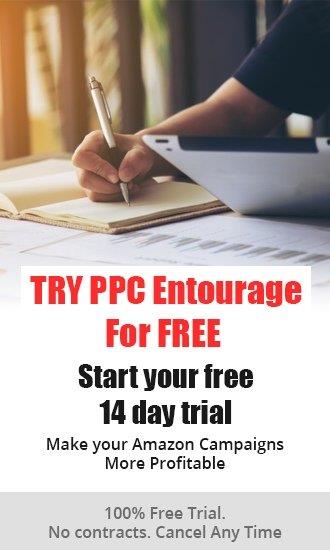Understanding how shoppers buy and lining up your Amazon ads to mirror their buying journey, can help you to increase your conversions, while laying a solid foundation for customer retention, and repeat sales.
In this blog, we're going to be looking at the Customer Buying Cycle and how to use the three main Amazon ad types (Sponsored Products, Sponsored Brands and Sponsored Display ads) to correspond with where shoppers are in their purchasing cycle.
The customer purchasing decision process is usually not linear. Shoppers can enter the purchase funnel at different stages. They may enter early at the top, the middle of it, or join late, right before they make their purchase. The goal is to serve the right type of ad at the right time.
The Customer Buying Cycle is the process a customer goes through when purchasing a product. They move through a series of buying stages in the cycle, as they educate themselves and draw closer to making a final purchasing decision.
While the exact buying cycle can be somewhat different for every product, every shopper goes through a similar process of…
- realizing they have a problem,
- considering their options for how to solve it,
- making a decision, and
- purchasing a solution.
Each phase requires that sellers use a different set of strategies to influence shoppers to move onto the next phase, because shoppers expect different interactions with sellers depending on which phase they’re in.
The Customer Buying Cycle consists of these stages...
Needs/Awareness stage is the first stage of the buying cycle. Potential customers realize that they have a problem that needs solving and begin to search for solutions. They may have an idea about what will help them but are not quite sure which brand, product, or solution will provide the best option.
Information search stage is when the shopper begins searching for the best solutions to meet their needs. Shoppers look for information that will help them to better understand their situation and identify what will solve their problem.
Evaluating alternatives. During this stage, shoppers weigh each possible solution against each other. They must determine what solution is the most trustworthy, affordable, highest quality, and highest performing. Shoppers look for reasons to believe why one solution has more benefits than another. They choose whichever product solution makes the most logical, emotional, or financial sense.
Purchase decision occurs when the research and evaluations are over. The shopper decides on the product that they wish to purchase and buys it.
Post purchase. The shopper has made a purchase. The shopper reflects on whether they have made the right decision. They consider whether the purchased solution accurately and fully meets their needs. They will feel either satisfaction or buyer’s remorse.
Amazon Advertising Campaigns
Successful sellers take advantage of the three main Amazon advertising types (Sponsored Products, Sponsored Brands, and Sponsored Display), in order to nurture shoppers at each stage of the customer buying cycle.
Sellers who understand what shoppers need at each stage of their purchasing journey and who match their Amazon advertising campaigns to that stage, are able to distribute their marketing budget in a targeted manner.
Sponsored Products Ads
Use these five types of Amazon Sponsored Products ad campaigns to identify and then test out which keywords, ASINs and categories are the most effective for connecting with potential buyers during the Needs/Awareness (Discovery) stage.
SP3 are Automatic Targeting campaigns.
SP4 are Automatic campaigns designed to catch low hanging fruit that traditionally has a low ACoS.
SP5 are Keyword Discovery campaigns designed to increase brand awareness and find new keywords to bid on and scale.
SP6 are Category Discovery campaigns designed to test categories and find new audiences and ASINs.
These Sponsored Products campaigns are used during the Consideration stage of the customer buying journey.
SP8 are Keyword ACoS Scraping campaigns used to find, test, and expand upon new keywords that are relevant to a seller's products and audience. These campaigns take search terms and ASINs that a seller may not have known about and convert them into keywords and targets that the seller can now bid on.
SP9 are ASIN ACoS Scraping campaigns used to identify those profitable ASINs that have worked well with a seller's advertising.
SP10 are Category Targeting with Refinements campaigns that allow sellers to refine for price, brand, and star ratings. These refinements allow sellers to set specific criteria for when their ads are shown. Sellers have the ability to target their competitors' products that are similar to theirs but have lower ratings when compared to what they are selling.
SP11 are Keyword Scale campaigns used during the Purchase stage of the customer buying cycle to help sellers to show up at Top of Search. The Search Term report is used to identify highly relevant keywords that have converted well (three or more sales) and that have a good ACoS. These keywords are placed into campaigns that align with the Purchase stage.
SP12 are ASIN Scale campaigns. They are also used to help place listings at the Top of Search during the Purchase stage.
SP13 are Brand Protection campaigns used during the Post Purchase stage of the customer buying cycle. They are campaigns that target a seller's own keywords as a means of staying in front of their customers, to lessen the odds that those customers will ‘stray’ to a competitor’s brand.
SP14 are ASIN Protection campaigns. These campaigns are also designed to help protect your brand by targeting a seller's own ASINs as a means of staying in front of their customers, to lessen the odds that those customers will ‘stray’ to a competitor’s brand.
Sponsored Brand Ads
These three types of Sponsored Brands campaigns can be used to get more exposure for a seller's brand during the Awareness/Discovery stage of the customer buying cycle. These campaigns are designed to showcase a seller's product line to new audiences and drive qualified traffic to it.
SB1 - Brand Discovery campaigns can be used to go after broad-based keyword searches and categories in order to help shoppers to see a seller's entire line of products.
SB2 - Product Line Discovery campaigns showcase a subset of products using a more refined set of keywords.
SB3 - Product Discovery campaigns help shoppers to discover a single product (and its variations), by sending them to a storefront sub-page or listing page that contains only that product.
SB4 - Refined Category/ACoS/ASIN Scraping. The Search Term Report is used to find categories, ASINs and search terms that have previously worked well and then targeting them with specific ads.
SB5 - Targeted Scale (Copy, Rinse, Repeat technique). A Sponsored Brands ad is set up tailored to a search term that has done exceptionally well for a particular product. A long-tailed search term can be placed into a headline and targeted as an Exact Match. This helps to make the ad hyper-relevant. Sellers can copy their best performing ads and tweak them so that they are aligned with the keywords that a shopper is searching with.
SB6 / SB7 – Once again, Brand Protection and ASIN Protection campaigns are performed in this stage of the customer buying cycle.
Sponsored Display Ads
Sponsored Display Ad campaigns can be used to create opportunities for sellers during the different stages of the customer buying cycle.
SD1 - Category Discovery. Sellers test different categories to find new opportunities and audiences.
SD2 - ASIN Discovery. Testing ASINs to see which ones perform the best.
SD3 - Interests, SD4 - Lifestyle, SD5 - Events. With Sponsored Display campaigns, sellers are able to target potential customers based upon their interests, lifestyle, and events.
SD6 - Searches Audience. These campaigns are for shoppers who have searched for a seller's product or a competitor's product.
SD7 - In Market. Sellers target shoppers who are in the market for something related to the product they are selling.
SD8 - Audience Remarketing. These campaigns target shoppers who have visited a seller's product listing or that of a competitor but have not yet purchased.
SD9 - Category Remarketing. These campaigns are for prospective customers who have viewed a seller's products, or similar products of a competitor.
SD10 - ASIN Scraping. These campaigns are used to identify those profitable ASINs that have worked well.
SD11 - Refined Category Targeting. These refinements allow sellers to set specific criteria for when their ads are shown.
SD12 - ASIN Scale. Identify all of the ASINs that have converted well in previous campaigns.
SD13 - Purchases Audience. These campaigns retarget past purchasers on and off Amazon and bring them back to make a purchase. These types of retargeting campaigns/ads help sellers to earn conversions they might not have realized otherwise.
SD14 - ASIN Defense/Cross Sell.
Use these Amazon Advertising strategies to better structure your campaigns based on which stage of the customer buying cycle a shopper may be in. In doing so, you place the odds in your favor that you will be able to sway potential customers to give you, rather than your competitor, their credit card number.
If you find yourself feeling confused or overwhelmed by the ever-changing world of Amazon ads, consider working with the experts at Entourage Management Services. They will construct an advanced advertising strategy based on your unique goals and budgets, and handle every aspect of your day to day advertising management.
Entourage: Software to Scale Amazon Ads and Results Driven Management.











